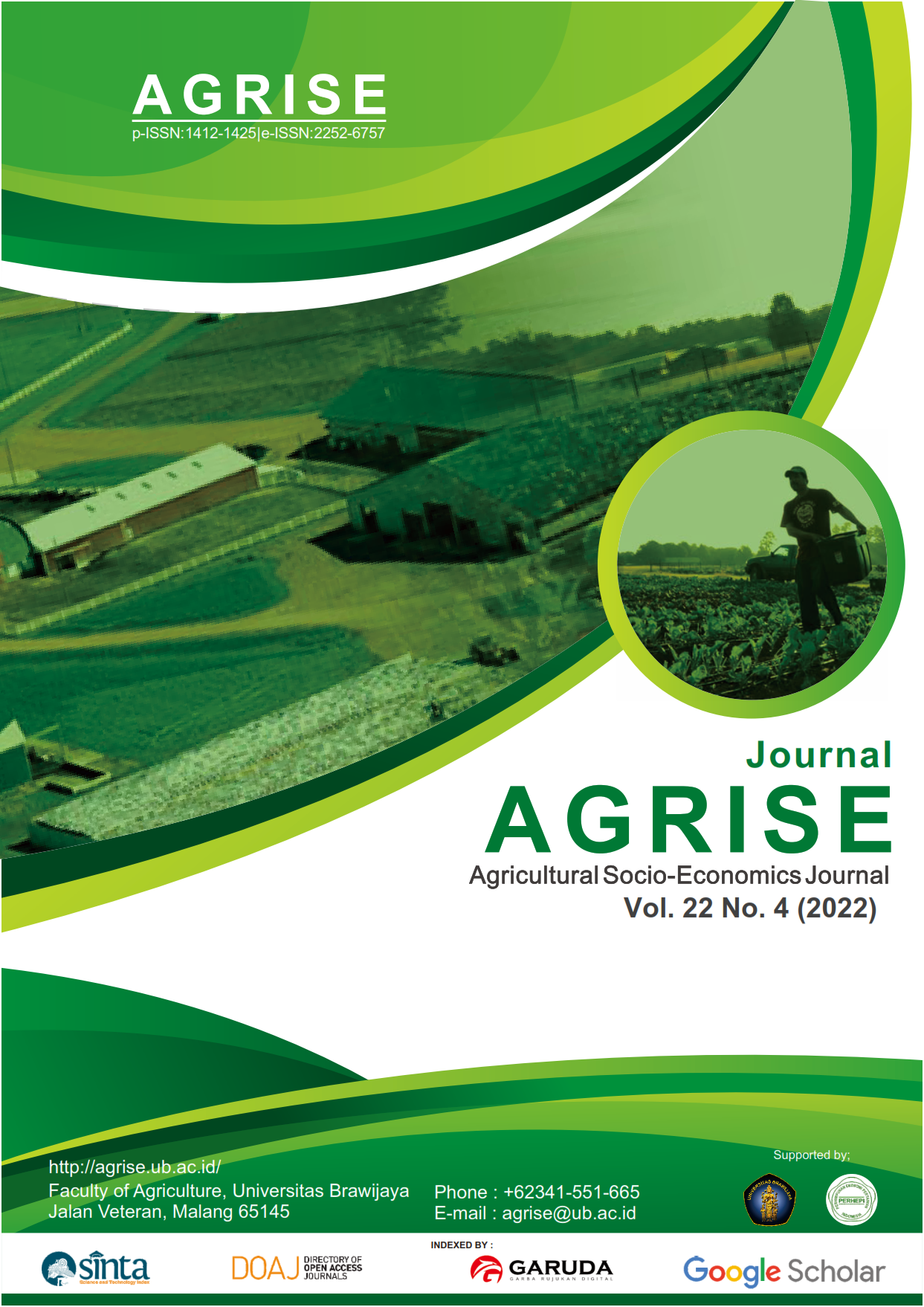ECONOMIC VALUATION OF "BEEJAY BAKAU RESORT (BJBR)" MANGROVE FOREST TOURISM PROBOLINGGO AND IT IS IMPACT TO THE ENVIRONMENT TOWARDS SUSTAINABLE RESOURCE MANAGEMENT
DOI:
https://doi.org/10.21776/ub.agrise.2022.022.4.14Keywords:
economic valuation, mangrove forest tourism, SDGs, social and economic ecological impactAbstract
Economic growth often occurs at the expense of the quality of natural resources and the environment because of the impact caused by economic activity. These impacts create external costs that the public and future generations must bear. Internalization of external costs must be enforced to prevent damage to natural resources and the environment (ex-ante strategy) or repair the damage that has occurred (ex-post strategy). Therefore, economic valuation is needed to provide important information regarding the value of ecosystems and the resulting economic benefits, especially for non-market environmental goods that have important policy implications and as an effort to achieve the Sustainable Development Goals (SDGs). This study aimed to analyze and estimate the economic value and identify the ecological, social and economic impacts at BeeJay Bakau Resort Probolinggo. Types of descriptive research with data collection methods include interviews, observations, documentation, and questionnaires. The sampling method used 2 methods: the accidental sampling technique for tourists by determining the number of samples using the linear time function formula so that a total sample of 84 respondents was obtained and the purposive sampling technique for stakeholders with a sample of 40 respondents. The results of the analysis show that the economic value generated is Rp. 584,347,909,947/year. The output of identification of ecological, economic and social impacts which includes three dimensions, namely the ecological, economic and social dimensions, each of which has 4 defined attributes, then it can be concluded that the ecological dimension has a high category, this is because the manager of the BeeJay Bakau Resort mangrove forest tourism carry out various efforts in development that involve both stakeholders and the surrounding community, especially in maintaining and committing to environmental sustainability.
References
Andronicus, A., Yulianda, F., & Fahrudin, A. 2016. Kajian Keberlanjutan Pengelolaan Ekowisata Berbasis Daerah Perlindungan Laut (Dpl) Di Psisir Desa Bahoi, Minahasa Utara, Sulawesi Utara. Journal of Engineering and Management Industial System, 4(1), 1–10. https://doi.org/10.21776/ub.jemis.2016.004.01.1
BMKG. 2019. Diambil kembali dari https://peta-maritim.bmkg.go.id/
Food and Agriculture Organization. 2007. The world's mangroves 1980-2005. Rome: Food and Agriculture Organization of the United Nations.
Fauzi, A. 2006. Ekonomi Sumberdaya Alam dan Lingkungan. PT. Gramedia Pustaka Utama. Jakarta.
Fauzi, A. 2014. Valuasi Ekonomi dan Penilaian Kerusakan Sumberdaya Alam dan Lingkungan. IPB Press. Bogor.
Gueabae.,H Krisnawati., S Taberima., S Kurnianto. 2015. The Potensial of Indonesian mangrove forests for global climate change mitigation. 15 (2), 1089-1092. doi:10.1038/NCLIMATE27
Gössling, S., Scott, D., & Hall, C. M. 2020. Pandemics, tourism and global change: a rapid assessment of COVID-19. Journal of Sustainable Tourism, 0(0), 1–20. https://doi.org/10.1080/09669582.2020.1758708
Harahab, N. 2016. Ekonomi Kehutanan (Teknik Pembibitan, Pengelolaan dan Penilaian Mangrove Berbasis TCM). Malang: Intelegensia Media.
Kementerian Lingkungan Hidup dan Kehutanan, K. 2017. Indonesia memiliki 23% Ekosistem Mangrove di Dunia dan Sebagai Tuan Rumah Konferensi Internasional Mangrove. Jakarta.
Kronenberg, K., & Fuchs, M. 2021. Aligning tourism’s socio-economic impact with the United Nations' sustainable development goals. Tourism Management Perspectives, 39(May), 100831. https://doi.org/10.1016/j.tmp.2021.100831
Kurniawan. 2016. Pengembangan Wisata Bahari Secara Berkelanjutan di Taman Wisata Perairan Kepulauan Ana6bas. Jurnal Ilmu dan Teknologi Kelautan Tropis Vol.8 (1).367-383.
Leitmann. 2009. Investing in a more sustainable Indonesia : Country enviromental analysis. CEA. Series. East Asia Pasific Region. Washington, DC : World Bank.
Putera, F. H. A., Fahrudin, A., Pratiwi;, N. T. M., & Susilo, S. B. 2013. Kajian Keberlanjutan Pengelolaan Wisata Pantai di Pantai Pasir Putih Bira, Bulukumba, Sulawesi Selatan. Jurnal Kepariwisataan Indonesia, 8(3), 241–254. https://www.academia.edu/34713836/Kajian_Keberlanjutan_Pengelolaan_Wisata_Pantai_di_Pantai_Pasir_Putih_Bira_Bulukumba_Sulawesi_Selatan.
Rovai, A. S., Coelho-Jr, C., de Almeida, R., Cunha-Lignon, M., Menghini, R. P., Twilley, R. R., Cintrón-Molero, G., & Schaeffer-Novelli, Y. 2021. Ecosystem-level carbon stocks and sequestration rates in mangroves in the Cananéia-Iguape lagoon estuarine system, southeastern Brazil. Forest Ecology and Management, 479(May 2020), 118553. https://doi.org/10.1016/j.foreco.2020.118553
Walcker, R. A.-M. 2015. Fluctuations in the extent of mangroves driven by multi-decadal changes in North Atlantic waves. J. Biogeogr. 42, 2209–2219. https://doi.org/ 10.1111/jbi.12580. .
WWF. 2020. Living Planets Report 2020. Netherlands.
Downloads
Published
How to Cite
Issue
Section
License
Copyright (c) 2022 Muhammad Fajar Maulana, Suhartini, Fahriyah

This work is licensed under a Creative Commons Attribution-NonCommercial 4.0 International License.
Authors who publish with this journal agree to the following terms:
- Authors retain copyright and grant the journal right of first publication with the work simultaneously licensed under a Creative Commons Attribution-NonCommercial License that allows others to share the work with an acknowledgment of the work's authorship and initial publication in this journal.
- Authors are able to enter into separate, additional contractual arrangements for the non-exclusive distribution of the journal's published version of the work (e.g., post it to an institutional repository or publish it in a book), with an acknowledgment of its initial publication in this journal.
- Authors are permitted and encouraged to post their work online (e.g., in institutional repositories or on their website) prior to and during the submission process, as it can lead to productive exchanges, as well as earlier and greater citation of published work (See The Effect of Open Access).











